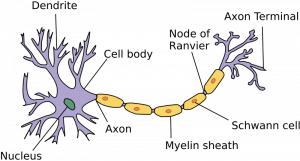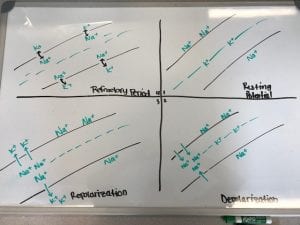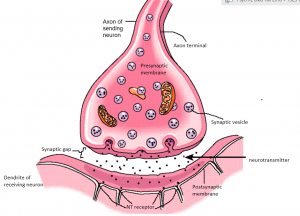A Neuron is a specialized type of cell that sends out nerve impulses.
Neuron structure
- Dendrites – Get their information from different neurons and sensory receptors
- Cell Body – The life support center of the cell
- Axon – Transports the neurons messages to different parts of the body
- Myelin Sheath – Surrounds the axon of some neurons to cover them, and helps increase the speed of neutral impulses
- Terminal Buttons – Creates junctions with the other cells
Neurons can be separated into three different groups:
- motor neurons
- sensory neurons
- interneurons
Neuron function
There are four steps on how an action potential moves along the neuron fibre: Resting Potential, Depolarization, Repolarization, Refractory Period.
- Resting Potential: This is the first step in action potential. The neuron has Positively charged potassium ions on the outside and more negatively charged ions on the inside then positive.
- Depolarization: The next step is called depolarization (sodium ions flow in). When a small section of the axon neighbouring the cell body is stimulated. In the stimulated spot pores in the membrane open up and allow positive ions to move inside the membrane of the cell making the inside more positive.
- Repolarization: The third step is called repolarization. Certain sections in the membrane open up and allow sodium ions out of the axon, causing the inside of the axon to return to its original charge. This causes depolarization to occur in the next section of the axon.
- Refractory Period: The last step in action potential is called the refractory period. When the positive and negative ions move back to their original places and the neuron returns to its resting state.
Synapse structure
Synapse function
When action potential gets to the end of the neuron, it causes a chemical signal (neurotransmitter) to be sent out to another neuron. The action potential then arrives at the axon terminal which then causes the synaptic vesicles to release NT in the synaptic gap. The NT then diffuses through the synaptic gap and latches onto the receptors on the postsynaptic membrane on the receiving neuron . The NT message can then be taken in one of two ways, excitatory (stimulates the AP on the other neuron) or inhibitory (represses the AP on the other neuron). If the receiving neuron produces its own AP then it will be excitatory, if not then it will be inhibitory. GABA and glutamate are both factors that affect weather the neuron will be excitatory or inhibitory.


